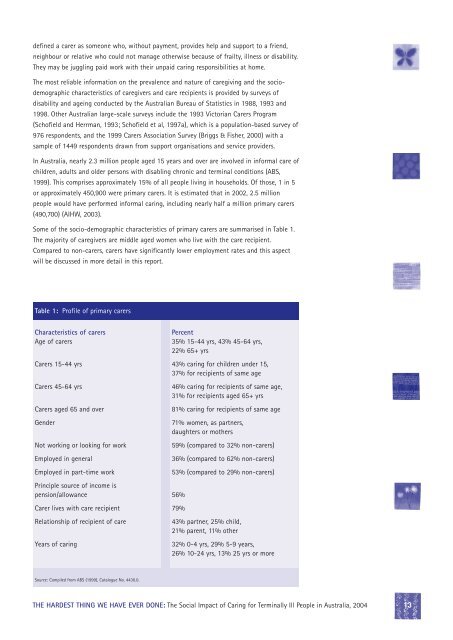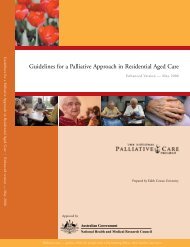The hardest thing we have ever done - Palliative Care Australia
The hardest thing we have ever done - Palliative Care Australia
The hardest thing we have ever done - Palliative Care Australia
Create successful ePaper yourself
Turn your PDF publications into a flip-book with our unique Google optimized e-Paper software.
defined a carer as someone who, without payment, provides help and support to a friend,<br />
neighbour or relative who could not manage otherwise because of frailty, illness or disability.<br />
<strong>The</strong>y may be juggling paid work with their unpaid caring responsibilities at home.<br />
<strong>The</strong> most reliable information on the prevalence and nature of caregiving and the sociodemographic<br />
characteristics of caregivers and care recipients is provided by surveys of<br />
disability and ageing conducted by the <strong>Australia</strong>n Bureau of Statistics in 1988, 1993 and<br />
1998. Other <strong>Australia</strong>n large-scale surveys include the 1993 Victorian <strong>Care</strong>rs Program<br />
(Schofield and Herrman, 1993; Schofield et al, 1997a), which is a population-based survey of<br />
976 respondents, and the 1999 <strong>Care</strong>rs Association Survey (Briggs & Fisher, 2000) with a<br />
sample of 1449 respondents drawn from support organisations and service providers.<br />
In <strong>Australia</strong>, nearly 2.3 million people aged 15 years and over are involved in informal care of<br />
children, adults and older persons with disabling chronic and terminal conditions (ABS,<br />
1999). This comprises approximately 15% of all people living in households. Of those, 1 in 5<br />
or approximately 450,900 <strong>we</strong>re primary carers. It is estimated that in 2002, 2.5 million<br />
people would <strong>have</strong> performed informal caring, including nearly half a million primary carers<br />
(490,700) (AIHW, 2003).<br />
Some of the socio-demographic characteristics of primary carers are summarised in Table 1.<br />
<strong>The</strong> majority of caregivers are middle aged women who live with the care recipient.<br />
Compared to non-carers, carers <strong>have</strong> significantly lo<strong>we</strong>r employment rates and this aspect<br />
will be discussed in more detail in this report.<br />
Table 1: Profile of primary carers<br />
Characteristics of carers<br />
Age of carers<br />
Percent<br />
35% 15-44 yrs, 43% 45-64 yrs,<br />
22% 65+ yrs<br />
<strong>Care</strong>rs 15-44 yrs 43% caring for children under 15,<br />
37% for recipients of same age<br />
<strong>Care</strong>rs 45-64 yrs<br />
<strong>Care</strong>rs aged 65 and over<br />
Gender<br />
Not working or looking for work<br />
Employed in general<br />
Employed in part-time work<br />
Principle source of income is<br />
pension/allowance 56%<br />
<strong>Care</strong>r lives with care recipient 79%<br />
Relationship of recipient of care<br />
Years of caring<br />
46% caring for recipients of same age,<br />
31% for recipients aged 65+ yrs<br />
81% caring for recipients of same age<br />
71% women, as partners,<br />
daughters or mothers<br />
59% (compared to 32% non-carers)<br />
36% (compared to 62% non-carers)<br />
53% (compared to 29% non-carers)<br />
43% partner, 25% child,<br />
21% parent, 11% other<br />
32% 0-4 yrs, 29% 5-9 years,<br />
26% 10-24 yrs, 13% 25 yrs or more<br />
Source: Compiled from ABS (1999), Catalogue No. 4430.0.<br />
THE HARDEST THING WE HAVE EVER DONE: <strong>The</strong> Social Impact of Caring for Terminally Ill People in <strong>Australia</strong>, 2004<br />
13
















